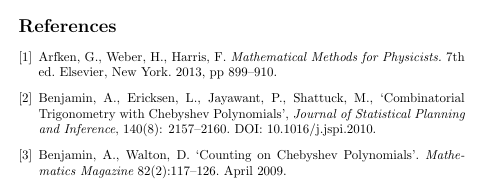
LaTeX is very good at automating three types of referencing: Bibliographical, equation, and page referencing. You can add in or removed referenced equation on the fly, and LaTeX will auto recalculate the correct numbering.
Let's start with bibliographical referencing. First, you make your bibliography, as for example:
\begin{thebibliography}{9}
\bibitem{Arfken}Arfken, G., Weber, H., Harris, F. {\it Mathematical Methods for Physicists.} 7th ed.\ Elsevier,
New York.\ 2013, pp 899--910.
\bibitem{Benjamin.et.al} Benjamin, A., Ericksen, L., Jayawant, P., Shattuck, M.,
`Combinatorial Trigonometry with Chebyshev Polynomials', {\it Journal
of Statistical Planning and Inference}, 140(8): 2157--2160. DOI: 10.1016/j.jspi.2010.
\bibitem{Benjamin&Walton}Benjamin, A., Walton, D.\ `Counting on Chebyshev Polynomials'.
{\it Mathematics Magazine} 82(2):117--126.\ April 2009.
\end{thebibliography}
This code looks like the following:

Now, to cite the third reference, for example, use the command:
\cite{Benjamin&Walton}
The way I cited it was
As to the importance of Chebyshev polynomials, I'll let experts in the field,
Benjamin \& Walton \cite{Benjamin&Walton}, describe it:
which looks like this:

Next, we go to the referencing of equations. Consider the equation pair
\begin{subequations}which looks like
\begin{align}
T_n(X_0) + X_1U_{n-1}(X_0)&= X_+^n \,. \label{eq:T_n(X_0)+.simpler}\\
T_n(X_0) - X_1U_{n-1}(X_0) &= X_-^n \,.\label{eq:T_n(X_0)-.simpler}
\end{align}
\end{subequations}

Now for the code that references it:
Now that we have $Y_0$ and $Y_1$, using (\ref{eq:T_n(X_0)+.simpler}) and
(\ref{eq:T_n(X_0)-.simpler}), we can write
which looks like this:
![]()
If I want to turn off automatic labeling of a specific displayed equation, all
I need to do is to place the string \notag on it. I usually place it at the end
of the line.
If I want LaTeX to skip an equation for auto labeling, yet force it to
make an equation label of my own choosing, all I need do is to place the
the string \tag*{(...)} at the end of the line. As an example, to tag the
equation with the label '(3.22)', just use the string \tag*{(3.22)}.
As another example, to tag the equation with the label '(*)', just use
the string \tag*{(*)}.
Lastly, we see how to reference a page. The following command '\pageref{page:Fig.1}'
tell the compiler to find the marker '\label{page:Fig.1}' somewhere in the LaTeX code
and return the page number of the page it resides on.